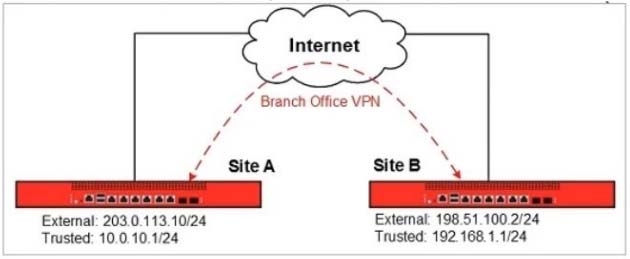In this diagram, which branch office VPN tunnel route must you add on the Site A Firebox to allow traffic between devices on the trusted network at Site A and the trusted network at site B? (Select one.)

In this diagram, which branch office VPN tunnel route must you add on the Site A Firebox to allow traffic between devices on the trusted network at Site A and the trusted network at site B? (Select one.)

To configure a VPN tunnel to allow traffic between the trusted networks at Site A and Site B, you need to define routes using the network addresses, not individual host addresses. The trusted network at Site A is 10.0.10.0/24, and the trusted network at Site B is 192.168.1.0/24. Therefore, the correct route configuration should be Local: 10.0.10.0/24 <--> Remote: 192.168.1.0/24.
I think the answer for this should be D. From my experience, adding the tunnels local and remote you use the Network ID in this case 10.0.10.0.24 <-> Remote: 192.168.1.0/24
yup the question is " to allow traffic between devices on the trusted network" and 10.0.10.1/24 is the ip address of the interface, the network is 10.0.10.0/24 the risht answer is the D.
I think it should be answer should be D. i have configured Bovpn 9 site-to-site Bovpn and i use network ID instead of host ID with subnet mask
definitely "D"
Correct answer is D, the network is .0 not .1
Definitely "D"
D because 10.0.1.1/24 and 192.168.1.1/24 are devices' interface
Oh it is D - Try to add the .1/24 into your Firebox VPN Route and you will receive an error message - So only D works and is a correct syntax for a network
D is correct. Question said trusted network so we should allow by network ID. BTW. devices won't allow to configure 10.0.10.1/24 format.
DDDDDDDDDDDDDDDDDDDDDDDDDDDDDDDDD
D D D D
Answer is D.
Answer is D.
Answer D
D, becaus .0 is the network address of this CIDR 24
Answer is D
10.0.10.1/24 is not a network CIDR. Right answer is D.